For a native of India, or for someone well-versed in Indian religion and culture, stories and references to Lord Krishna are not new. Children have been raised on tales glorifying this favorite deity, especially stories of his childhood, and it is very common for boys to be named after Lord Krishna. His popularity is such that there is a whole art form, called Pichwai, dedicated to showcase the life and achievements of the god.
Pichwai, traditionally used to depict Lord Krishna’s tales, literally mean ‘backdrop’ or ‘hanging at the back’. Pichwai art was created on large cloth canvases and used to provide a screen behind idols in Nathdwara temples, and even small temples in homes. Pichwai art is deeply religious and is considered by the artist to reflect his love for Lord Krishna. Each painting is detailed and intricate, can take three to nine months to complete, and is considered to be an offering to the temple’s deity Lord Srinathji, the child manifestation of Lord Krishna. Pichwai artists use basic colors to create a vibrant collage of living beings, nature, festivals, pastoral scenes, Lord Krishna, Radha and their cohorts. Krishna leela is another favorite topic.
The legend of Srinathji
According to folklore, in the 17th century, the devotees of Lord Krishna decided to move his idol from Vrindavan to protect it from the plundering forces of Aurangzeb by way of a bullock cart. When they were travelling in Rajasthan, a state in western India, it is said the wheels of the cart sank deep into the soil and despite several attempts they could not be moved. The devotees took it as a sign from the lord that this was the chosen spot. Since then Nathdwara has been home to Lord Srinathji. Interestingly, to the devotees the idol in the temple is not just a stone figure, but a living, playful divine child, who is fed, bathed, dressed, and even sent out to play. We can still see the bullock cart displayed at the temple.
Themes in Pichwai art
In Pichwai paintings, Lord Srinathji is always shown amidst opulent settings. He is depicted with his left hand raised and the right hand resting at the waist, and a large diamond placed under his lips. Ornate golden embellishments and bright colors always surround the deity. The background displays lush green natural surroundings, dancing gopis or milkmaids, performing musicians etc. The adult Krishna is painted in blue and is usually shown standing on an open lotus flower playing his flute. Overall there is a display of festivity and joy in a celebration of god and nature. Initially vegetables dyes were used to prepare the colored paints, but over time Pichwai artists also started using mineral dyes. In Pichwai paintings, the image of Srinathji with raised left hand depicts the moment when he is believed to have protected the villagers by holding the Govardhan hill for them to take shelter during the terrible rainstorm let loose by an angry God Indra.
Creating Pichwai art
Creating a Pichwai painting is not for the impatient or the faint-hearted. It takes a lot of effort and can take weeks, or even months depending on the size and intricacy required. The beauty of Pichwai art also lies in the use of a variety of pigments like metallic, organic, minerals and synthesized minerals. Pichwai art can be embroidered, painted or woven. There is delicate and elaborate embroidery, fine painting and even gem work. The canvas or cloth which acts as the base is called bhumiband in the local language. It is pasted on a plain surface and polished well for a smooth base. The Pichwai artist first sketches out the composition using black or red ink, and then finally fills in the colors made from gold, coal, silver, indigo, zinc, saffron and other minerals. The figures in Pichwai paintings always have huge eyes, a sharp nose and vibrantly colored costumers. Each piece of garment is painted or woven intricately with very fine details, such as sheer dupattas (long scarves) of Radha or gopis which are edged with fine gold paint, or intricate gem worn in the crown and jewelry. Srinathji is always painted in festive colors and costumes.
What sets Pichwai art apart is that there is so much detailing that there’s no room for error or a re-do, or even a touch-up. It thus takes a lot of skill and experience to create Pichwai art.
Pichwai paintings in modern times
Once committed to depicting only Lord Krishna and everything related to him, Pichwai art has changed over the years to cater to the changing sense of art and aesthetics. The paintings are no longer large, and have been resized to being two to three feet long so that art lovers can decorate their homes. Even the subject of the art has changed to reflect more contemporary tastes in terms of colors, features and composition. Even though natural colors and paint brushes have been replaced, Pichwai continues to evoke a lot of interest.
About the author: Sushmita Vobbilisetty is the concept creator at Chitrapata. She has a deep understanding of old masters, modern, and contemporary artworks. Sushmita is an expert in evaluating the market value and fair value of art based on heritage, availability, sell-through rate, market performance over time, secondary sales track record, and other key factors. Sushmita frequently predicts the bidding prices for day sales and evening auctions hosted by leading art houses.
About us: Chitrapata is a digital atelier with an in-house generative art technology platform enhanced with machine learning and artificial intelligence capabilities. Our vision is to spark thoughts, conversations, and debates among different groups. Visit “About us” section to know more about our philosophy, vision, bio, artist statement, story and technology process.
Image credit: DreamStudio AI, StableDiffusion.

